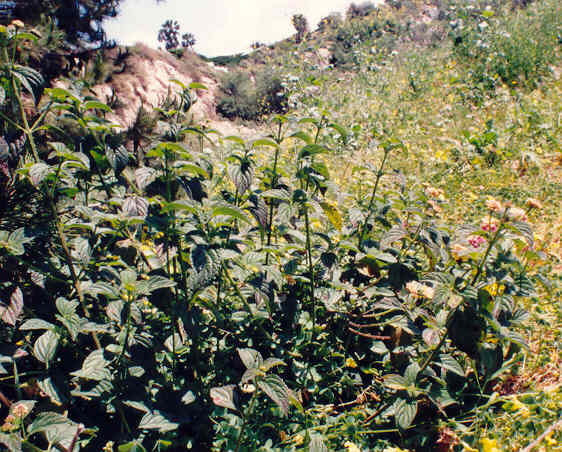
Lantana camara L. var. aculeata Moldenke
Verbenaceae (Vervain Family)
Tropical America
Lantana
 |
Lantana camara L. var. aculeata MoldenkeVerbenaceae (Vervain Family)Tropical AmericaLantana
Moldenke |
April Photo
Plant Characteristics:
Hairy shrub to 6 ft. or more, armed with stout recurved prickles; lvs.
opposite, ovate or oblong-ovate, 1-5 in. long, mostly short-acuminate,
crenate-dentate, short-petioled, rather thick, rugose, scabrous above, pubescent
beneath; heads dense, 1-2 in. across, flat topped, on stout axillary peduncles
often longer than lvs.; bracts narrow, about half as long as corolla; fls.
1/4-1/2 in. long, usually opening yellow or orange but changing to red or
scarlet; calyx very small; corolla somewhat irregularly 4-5 parted but not
bilabiate, the tube slender; stamens 4, didynamous, attached midway in the tube,
included; ovary 2-celled, becoming a fleshy drupe with 2 bony nutlets.
Habitat:
Tropical America north to Texas and south Georgia.
(Bailey 842). Disturbed
slopes, abandoned fields, urban weed below 200 meters.
Southern counties as a waif; naturalized
+/- worldwide; perhaps native to Caribbean.
(Hickman, Ed. 1086). Escape from cultivation.
Name:
Lanta-na, old Latin name, also applied to Viburnum which it
resembles. Camara, a South
American name. (Bailey 842).
Aculea-tus, prickly. (Bailey
10).
General:
Rare in the study area, having been found only once and this near the toe
of the bluff at Northstar Beach. (my
comment). Lantana camara,
has occasionally been used by natives for tea, however, the strong scent and
flavor is not appreciated by most people. (Meyer
172). See Lantana
camera for additional information on the species. (my
comment). Approximately
150 species. (Hickman, Ed. 1086).
Text Ref:
Bailey 842; Hickman, Ed. 1086; Munz, Flora So. Calif. 850.
Photo Ref:
April 95 # 18,19.
Identity: by R. De Ruff, confirmed by John Johnson.
First Found: April 1995.
Computer Ref: Plant Data 482.
Plant specimen donated to UC Riverside in 2004.
Last edit 8/8/05.
 |
April Photo